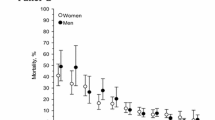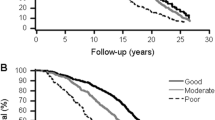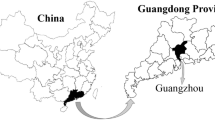Abstract
Health-related quality of life (HRQOL) measures predict cause-specific mortality, but few studies have explored whether generic self-reported HRQOL measures are independently associated with mortality in community-dwelling older persons. We postulated that a general measure of HRQOL, the short form 36-item questionnaire (SF-36), would be independently predictive of mortality among community-dwelling older persons. To evaluate this hypothesis, we followed a fixed cohort of 4,424 community-dwelling older persons recruited from a 2000 population-based survey in Taiwan until 2003 and investigated whether HRQOL was predictive of 3-year mortality, even after adjusting for traditional clinical risk variables. The data were collected via a door-to-door survey, and interviewers collected information on the subjects’ demographics, medical history, utilization of health services, functional ability, falls, and self-reported physical and mental symptoms. Of the 6053 eligible subjects, 4,424 residents agreed to participate in the baseline survey and were contacted in 2003. During the 3-year period, the 3-year cumulative mortality rate for the study population was 5%. Mortality was significantly higher among males (5.57% vs. 4.27%, p = 0.049), and cumulative mortality increased with age (χ 2-test for trend; χ 2 = 7.734, p = 0.001). For all scales except bodily pain, there was a significant relationship between a 10-point lower baseline score and mortality. Our primary multivariate risk model, which included two summary measures of HRQOL and significant clinical variables, demonstrated that a 10-point decrease in either the baseline Physical Component Summary (PCS) score or the baseline Mental Component Summary (MCS) score was associated with higher mortality (PCS: RR: 1.60, 95% CI: 1.39–1.83; p<0.001; MCS: RR: 1.16, 95% CI: 1.01–1.34; p = 0.036). The findings suggested that low baseline PCS and MCS scores were important independent risk factors for 3-year mortality among community-dwelling older persons, even after adjusting for other risk factors.
Similar content being viewed by others
References
World Health Organization (1948) The first years of the World Health Organization. WHO, Geneva
Brazier JE, Harper R, Jones NM, O’Cathain A, Thomas KJ, Usherwood T et al. (1992) Validating the SF-36 health survey questionnaire: new outcome measure for primary care. BMJ 305(6846):160–64
McHorney CA (1999) Health status assessment methods for adults: Past accomplishments and future challenges. Annu Rev Public Health 20:309–35
Bergner M (1989) Quality of life, health status, and clinical research. Med Care 27(3):S148–S156
Jones MB (1977) Health status indexes: the trade-off between quantity and quality of life. Socioecon Plann Sci 11(6):301–05
Horley J (1984) Life satisfaction, happiness, and morale: two problems with the use of subjective well-being indicators. Gerontologist 24(2):124–27
Study protocol for the World Health Organization project to develop a Quality of Life assessment instrument (WHOQOL) (1993) Qual Life Res 2(2):153–59
Idler EL, Benyamini Y (1997) Self-rated health and mortality: A review of twenty-seven community studies. J Health Soc Behav 38(1):21–7
Rumsfeld JS, MaWhinney S, McCarthy M Jr, Shroyer AL, VillaNueva CB, O’Brien M et al. (1999) Health-related quality of life as a predictor of mortality following coronary artery bypass graft surgery. Participants of the Department of Veterans Affairs Cooperative Study Group on processes, structures, and outcomes of care in cardiac surgery. JAMA 281(14):1298–303
Tibblin G, Svardsudd K, Welin L, Erikson H, Larsson B (1993) Quality of life as an outcome variable and a risk factor for total mortality and cardiovascular disease: A study of men born in 1913. J Hypertens 11(4):S81–S86
Konstam V, Salem D, Pouleur H, Kostis J, Gorkin L, Shumaker S et al. (1996) Baseline quality of life as a predictor of mortality and hospitalization in 5,025 patients with congestive heart failure. SOLVD Investigations. Studies of Left Ventricular Dysfunction Investigators. Am J Cardiol 78:890–95
Bosworth HB, Siegler IC, Brummett BH, Barefoot JC, Williams RB, Clapp-Channing NE et al. (1999) The association between self-rated health and mortality in a well-characterized sample of coronary artery disease patients. Med Care 37(12):1226–236
Mapes DL, Lopes AA, Satayathum S, McCullough KP, Goodkin DA, Locatelli F et al. (2003) Health-related quality of life as a predictor of mortality and hospitalization: the Dialysis Outcomes and Practice Patterns Study (DOPPS). Kidney Int 64(1):339–49
Kalantar-Zadeh K, Kopple JD, Block G, Humphreys MH (2001) Association among SF-36 quality of life measures and nutrition, hospitalization, and mortality in hemodialysis. J Am Soc Nephrol 12:2797–806
Sprenkle MD, Niewoehner DE, Nelson DB, Nichol KL (2004) The Veterans Short Form 36 questionnaire is predictive of mortality and health-care utilization in a population of veterans with a self-reported diagnosis of asthma or COPD. Chest 126(1):81–9
Domingo-Salvany A, Lamarca R, Ferrer M, Garcia-Aymerich J, Alonso J, Felez M et al. (2002) Health-related quality of life and mortality in male patients with chronic obstructive pulmonary disease. Am J Respir Crit Care Med 166(5):680–85
Fan VS, Curtis JR, Tu SP, McDonell MB, Fihn SD (2002) Using quality of life to predict hospitalization and mortality in patients with obstructive lung diseases. Chest 122:429–36
Health and Vital Statistics, Taiwan Area. Taipei: Department of Health, Republic of China, 2004
Tsai SY, Cheng CY, Hsu WM, Su TP, Liu JH, Chou P (2003) Visual impairment and depression in the elderly. J Formos Med Assoc 120(2):86–0
Tsai SY, Chi LY, Cheng CY, Hsu WM, Liu JH, Chou P (2004) The impact of visual impairment and use of eye services on health-related quality of life among the elderly in Taiwan: The Shihpai Eye Study. Qual Life Res 13(8):1415–424
Tsai SY, Chi LY, Lee LS, Chou P (2004) Health-related quality of life among urban, rural, and island community elderly in Taiwan. J Formos Med Assoc 103(3):196–04
Ware JE, Sherbourne CD (1992) The MOS 36-item short-form health survey (SF-36). I. Conceptual framework and item selection. Med Care 30(6):473–83
Chie WC, Huang CS, Chen JH, Chang KJ (1999) Measurement of the quality of life during different clinical phases of breast cancer. J Formos Med Assoc 98(4):254–60
Wang SJ, Fuh JL, Lu SR, Juang KD (2001) Quality of life differs among headache diagnoses: Analysis of SF-36 survey in 901 headache patients. Pain 89(2–):285–92
Fuh JL, Wang SJ, Lu SR, Juang KD, Lee SJ (2000) Psychometric evaluation of a Chinese (Taiwanese) version of the SF-36 health survey amongst middle-aged women from a rural community. Qual Life Res 9(6):675–83
McHorney CA, Ware JE, Lu JF, Sherbourne CD (1994) The MOS 36-item short-form health survey (SF-36). III. Tests of data quality, scaling assumptions, and reliability across diverse patient groups. Med Care 32(1):40–6
McHorney CA, Ware JE, Raczek AE (1993) The MOS 36-item short-form health survey (SF-36). II. Psychometric and clinical tests of validity in measuring physical and mental health constructs. Med Care 31(3):247–63
Ware JE, Kosinski M, Keller SD (1994) SF-36 Physical and Mental Health Summary Scales — a users manual. The Health Institute, Boston
Ware JE (1993) SF-36 Health Survey Manual and Interpretation Guide. The Health Institute, New England Medical Center, Boston
Kjoller M, Rasmussen NK, Keiding L (1995) Health and Disease in Denmark 1994. Danish Institute for Clinical Epidemiology, Copenhagen
Mortensen OS, Madsen JK, Haghfelt T, Grande P, Saunamaki K, Haunso S et al. (2000) Health related quality of life after conservative or invasive treatment of inducible postinfarction ischaemia. Heart 84(5):535–40
Dominick KL, Ahern FM, Gold CH, Heller DA (2002) Relationship of health-related quality of life to health care utilization and mortality among older adults. Aging Clin Exp Res 14(6):499–08
Inouye SK, Peduzzi PN, Robison JT, Hughes JS, Horwitz RI, Concato J (1998) Importance of functional measures in predicting mortality among older hospitalized patients. JAMA 279(15):1187–193
Andresen EM, Vahle VJ, Lollar D (2001) Proxy reliability: health-related quality of life (HRQoL) measures for people with disability. Qual Life Res 10(7):609–19
Melchior M, Berkman LF, Niedhammer I, Chea M, Goldberg M (2003) Social relations and self-reported health: a prospective analysis of the French Gazel cohort. Soc Sci Med 56(8):1817–830
Lee GR (1985) Kinship and social support of the elderly: The case of the United States. Ageing Soc 5:19–8
Lynn J, Ely EW, Zhong Z, McNiff KL, Dawson NV, Connors A et al. (2000) Living and dying with chronic obstructive pulmonary disease. J Am Geriatr Soc 48(5):S91–S100
Macfarlane GJ, McBeth J, Silman AJ (2001) Widespread body pain and mortality: Prospective population based study. BMJ 323(7314):662–65
Centers for Disease Control, Prevention. (2002) Measuring Healthy Days. CDC, Atlanta, Georgia
Acknowledgments
This study was supported by a grant from the Taipei Veterans General Hospital (VGH89-404-1, VGH90-445-1, and VGH91-382-1) and DOH-MD-MI9001.
Author information
Authors and Affiliations
Corresponding author
Rights and permissions
About this article
Cite this article
Tsai, SY., Chi, LY., Lee, Ch. et al. Health-related quality of life as a predictor of mortality among community-dwelling older persons. Eur J Epidemiol 22, 19–26 (2007). https://doi.org/10.1007/s10654-006-9092-z
Received:
Accepted:
Published:
Issue Date:
DOI: https://doi.org/10.1007/s10654-006-9092-z




